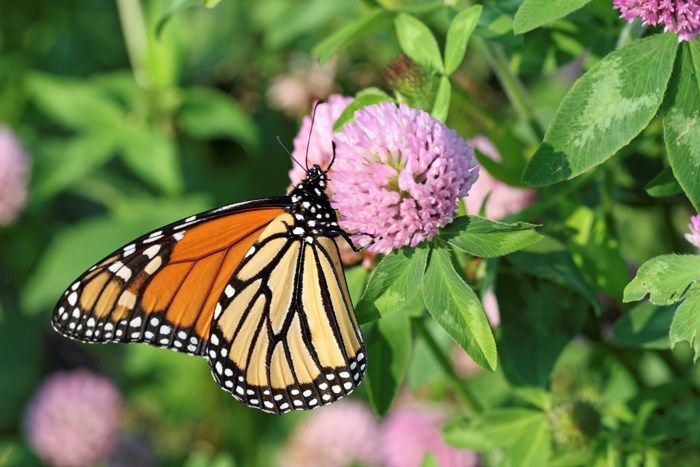Did you know that about one-third of the world’s food crop production relies on pollination? Perhaps due to this connection, the plight of pollinators (bees in particular) has recently become highly publicized worldwide. Todd Farrell, conservation biologist with the Nature Conservancy of Canada (NCC) says that while bees have been the poster child in the media, other pollinators such as butterflies and moths that are facing similar challenges should not be left out.
“We are just beginning to understand pollinators’ importance in our ecosystems and food systems, and their status in the wild,” says Todd. “Insect diversity is vast and there’s a lot we still don’t know. Building up this knowledge base can help us better manage our lands.” Farrell says that by conducting targeted surveys and contributing to province-wide counts, NCC scientists are able to gather more information on population sizes, trends and the locations of certain pollinator species.
For example, findings from one of last year’s moth surveys at an NCC property in the Rice Lake Plains Natural Area proved great potential as a core area for provincially and nationally significant moths. While conservation organizations like NCC are making progress in the field and helping us build a better picture of pollinators on the lands they protect, change can happen right at home.
Here are three ways you can be a champion for our pollinators:
Pollinator friendly plants and wildflowers
Species such as wild bergamot and black-eyed Susan are examples of plants suitable in all areas. However, some plants may only be appropriate for a certain habitat type or climatic zone. Use native plant guides to learn about what’s appropriate for your area.
Plants that pollinators will love include bee balm, milkweed and other nectar- and pollen-rich species. Choosing a variety of plants that flower at different times of the year helps ensure a steady food supply for our pollinators!
Tip: Once you’ve selected your seeds, help them germinate by sealing the seeds in a Ziploc bag with a damp paper towel. Then store them in the refrigerator for a few weeks until the risk of frost has passed.
Water and salt licks
Access to fresh, clean water is essential for pollinator health. Line a shallow dish with a few pebbles as landing pads, and voilà: a hydration station for your ladybugs, butterflies, bees and more.
Butterflies also use salt licks to satisfy a need for nutrients and minerals. Make your garden more inviting by creating a damp area over bare soil mixed with a little sea salt for a DIY salt lick.
Tip: Spot a grounded, exhausted bee straggling about? Help get it back on its feet (or wings rather) by offering a spoon with sugar water.
Nesting havens
You may be surprised that not all bees live in hives; in fact, of Canada’s 800 native bee species, about 30 percent are solitary and live in underground burrows, wood tunnels or other cavities.
Tip: Even without any carpentry skills, you can build a bee condo using wood blocks and hollow stems.
Will you help bring back the buzz of pollinators this season? Find out how you can help by contacting your local NCC office and sign up for volunteer opportunities such as tree plantings, invasive species removal and butterfly counts at www.natureconservancy.ca.



